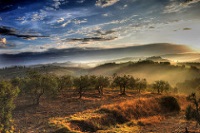
A circular route from Siena through the Chianti hills provides visitors to Tuscany with a wonderfully scenic and sensory travel experience. The route covers the villages of the Chianti Classico wine region, garnished with ancient castles and rambling farmhouses. The vineyards and wooded hills of the Chianti are best explored along its winding back roads or from within its sleepy hamlets. By car, visitors should keep a lookout for signs marked 'vendita diretta' ('direct sales'). The first stop is at Castello di Brolio, a magnificent vineyard owned by the Ricasoli family since 1167. The SS484 will take you south of Brolio and north past the hamlets of San Gusme, Campi and Linari before rejoining the road for a diversion to the Meleto castle. Another worthwhile stop is at Badia a Coltibuono, for its restaurant and Romanesque church. The winding road west to Radda, in Chianti, is especially picturesque. A further nine miles (15km) from here is the hamlet of Volapia, a delightful place which makes you feel as though you've travelled back in time; as does a visit to sleepy Castellina. Within the ramparts of this walled village is the Bottega del Vino Galla Nero, at Via della Rocca 13, showcasing the region's delectable wines and olive oils. There are many potential detours and attractions in the region and although it is a good idea to pick a few desired stops in advance it is a joy to just get lost in the area.
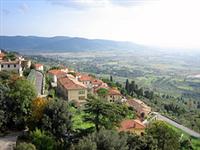
Cortona is a richly historic city that enjoys a scenic position above Lake Trasimeno and the plain of Valdichiana, dotted with olive groves and vineyards. It is one of Tuscany's oldest cities, and home to some of its best-preserved Etruscan buildings. Cortona also has a strong artistic pedigree, reflected in its status as a 'City of Art', and was home to Luca Signorelli and Pietra da Cortona. The ancient city has become even more popular due to being the location for several much loved books by Frances Mayes.Most of the Etruscan city is hidden in basements but part of the original 4th-century BC walls can be seen at the base of Porta Colonia's outer side. Climbing the city's cut-stone staircases and meandering along its cobbled streets guides one back through the past from the Renaissance to the Middle Ages and beyond. The medieval houses along Via Janelli are the oldest in Italy; massive timber beams support their overhanging upper stories. Other places of special interest for people on holiday in Cortona include the Palazzo Comunale, Museo dell'Accademia Etrusca (containing a number of major Etruscan artefacts) and the church of San Francesco, the first Franciscan church outside Assisi.
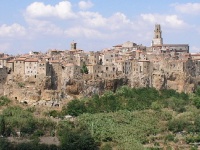
Attracted by the mineral wealth found in the regions of Tuscany, Lazio and Umbria, the Etruscans made their way to Italy around 900 BC. Traces of Etruscan civilisation can be found in their burial sites and in the artefacts found in their tombs. They were preoccupied with the afterlife and dedicated much effort to building burial sites carved into rock, or constructed from stone slab and reached by purpose-built rock-cut roads.For an exploration of Etruscan artefacts start at Grosseto. The Museo Civico Archeologico in Grosseto contains a selection of Etruscan artefacts that were found in tombs nearby. Head north from here to Roselle, the most important excavated Etruscan and Roman remains in Tuscany. From here, follow the road leading east for 34 miles (54km) to the Etruscan village of Saturnia to explore its rock-cut tombs and then on to Sovanato to see the famous Ildebranda Tomb.The town of Pitigliano is peppered with Etruscan tombs and tunnels. The town itself is a spectacular vista of houses jutting out over soft limestone cliffs and caves bordering the River Lente. The cliffs contain numerous caves that have been used to store local wines and olive oils and the town itself is a labyrinth of medieval streets that have carried the passage of many a traveller. From this quaint town, head west to the extensive necropolis on the outskirts of Marsiliana. Complete the trip with a stop at Talamone and Maremma, for a visit to the Etruscan temple, Roman villa and baths.In addition to these more famous examples, the region is scattered with evidence of the Etruscans - look out for signposts as you explore!
Address : Lazio and Umbria
Website : whc.unesco.org/en/list/1158
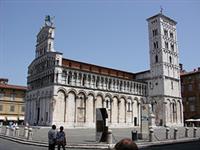
The charming city of Lucca is laid out on ancient Roman roads and framed within well-preserved and photogenic medieval ramparts. It is an ancient city, founded by the Etruscans and a Roman colony from 180 BC, and still boasts many fascinating old buildings. The city walls are one of the main attractions as they are still perfectly intact despite the expansion of the city and their great age.The city is also famous for being the home of Puccini and has an appropriate reputation for wonderful chamber music. Casa di Pucini makes an interesting visit for opera lovers on holiday here, as this 15th-century house is a shrine to the composer who lived and worked here. Lucca is also celebrated for its museums, monuments and splendid Romanesque churches. With its flat terrain and narrow lanes, Lucca is perfectly suited to explorations on foot or by bicycle, the same methods local people use to commute.Key sights on a visit to Lucca are the Duomo, San Michele, San Frediano, Museo Nazionale Guinigi and Torre Guinigi. The remains of an ancient Roman amphitheatre can be found on Piazza del Mercato, lined by buildings dating from the middle ages.
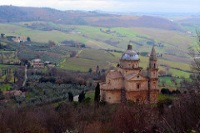
Montepulciano is Tuscany's highest hilltop town, built along a narrow limestone ridge at 1,950ft (605m) above sea level. Although not quite as well known as some of the other historic hill villages in Tuscany, Montepulciano is fast being 'discovered' by tourists seeking out the best of the region, and it benefits from not being thronged by visitors, retaining its mystery and authenticity. Sheltered within the town's fortified walls are charming streets packed with Renaissance-style palaces and churches. Within the incredibly intact historic centre no major building work has been done since 1580, making it one of the best-preserved historic centres in Italy. Montepulciano's most celebrated achievement is its Vino Nobile wines. Also of interest is the Madonna di San Biagio, a delightful pilgrimage church on the outskirts of the town. For a dip into Etruscan reliefs and funerary urns collected by Pietro Bucelli, visit his Palazzo on Via di Gracciano del Corso 73. For splendid views, take a stroll to the Palazzo Communale and climb the tower. The village also boasts some lovely Tuscan restaurants and is wonderfully picturesque, with a backdrop of vineyards, corn, sunflowers and distant forested hills. It would be difficult to be bored or unimpressed in this special village.
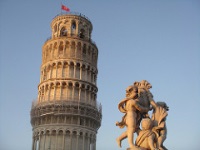
The holiday destination of Pisa is most famous for its leaning campanile; yet its other equally notable coups include its long maritime legacy, dating to 1000 BC, its prized university, and its status as the birthplace of the world's greatest physicist and astronomer, Galileo Galilei. The Pisans also created one of the most beautiful squares in the world in the Campo dei Miracoli (Field of Miracles).Pisa's key component is the famous Leaning Tower, an essential holiday attraction, whose layers of heavy marble were constructed on a shifting subsoil foundation that has been the bane of Pisan engineers for more than 800 years. It seems that the tremulous soil underneath the Field of Miracles has exacted its price on the other buildings too, most notably San Michele dei Scalzi. Other attractions of interest in Pisa include the Museo delle Sinopie, a museum containing a display of sketches from the frescoed cycle that decorated the walls of the Campo Santo cemetery; and the Museo dell'Opera del Duomo, in which exhibits of arabesque panels and Corinthian capitals reveal the influences of Rome and Islam on Pisan architects. The Museo Nazionale di San Matteo displays a range of Florentine art from the 12th through to the 17th-centuries.Pisa is a popular daytrip from Florence, and a beloved Italian destination in its own right.
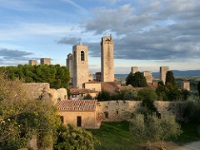
San Gimignano is a popular village on the tourist trail which attracts many with its charm and history. The distinctive skyline of the charming medieval village of San Gimignano is redolent of a modern cityscape with its many towers, hence its nickname the 'medieval Manhattan'.Only 14 of the original 72 towers remain, however, which is unsurprising as their dual role as status symbols and defensive structures saw them caught in the middle of the many feuds and battles that eventually caused the town's downfall. Nevertheless, these 14 towers are among the best-preserved in Italy, and are the envy of Florence and Bologna whose towers have long since been destroyed. San Gimignano enjoyed an ideal position on the main pilgrimage route connecting Northern Europe and Rome and prospered during the Middle Ages. In modern times, its fortune stems from tourism and wine production.The ideal starting-point for a visit to San Gimignano is the Piazza del Duomo, which is the centre of the town and framed by historical buildings. Nearby is the Collegiata, a church dating from the 11th-century and famed for its frescoes, which include The Creation by Bartolo di Fredi. For shopping and souvenirs, head to Via San Giovanni.
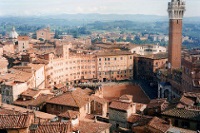
Siena is one of Italy's best-preserved medieval cities, and one of the major drawcards for visitors to the popular regions of Umbria and Tuscany. The city's historic centre is a UNESCO World Heritage Site and is only accessible on foot. Siena's peak as a wealthy city-state dates back to the 13th-century, when the Duomo di Siena was completed along with the distinctly scallop-shaped Piazza del Campo, regarded as one of the finest public spaces in Europe. The town's university was founded in 1240, and to this day ranks as one of the most prestigious in Italy, while its student population enlivens the traditionally conservative local population.Amid the winding lanes of the medieval city are many gorgeous churches and museums, filled with artistic riches. Chief among these are the 13th-century Gothic-styled Chiesa di San Domenico and the imposing Fortezza Medicea; while the Sanctuary of St. Catherine's of Siena is a pilgrimage site for many seeking benefits from the reputedly miraculous crucifix it houses.All of Siena's streets are a delight to explore while on holiday but some of its most notable landmarks include the Torre de Mangia, Palazzo Pubblico, the Duomo, Palazzo Piccolomini, Pinacoteca Nazionale and Museo dell'Opera. Torre del Mangia is the bell tower to the left of Palazzo Pubblico which stands at 330ft (102m), the second highest in Italy. It is named after the first bell ringer who was known for his infuriating idleness. The Palazzo Pubblico still serves as Siena's town hall although sections of it are open to the public. The Palazzo Piccolomini, built in 1460 for the prosperous Piccolomini family, contains Sienese state archives and financial records. The Pinacoteca Nazionale gallery is noted for its collection of works by artists of the Siena School. Siena's spectacular Duomo is unsurpassed amongst Italy's churches, built in full Gothic style. The carved pulpit panels, by Nicola Pisano, are magnificent depictions from The Life of Christ. Many of the original statues on the church's façade are copies; the originals are in the Museo dell'Opera del Duomo.

Travel Guide powered by Word Travels, copyright © 2023 Globe Media Ltd. By its very nature information in this travel guide is subject to change at short notice and travellers are urged to verify information on which they're relying with the relevant authorities. Neither Globe Media Ltd nor Travel Vogue can accept any responsibility for any loss or inconvenience to any person as a result of information contained above.